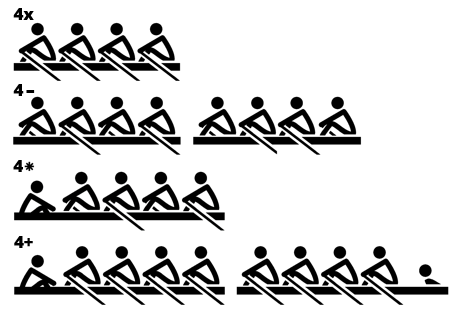|
|
Rowing dictionary – F |
Feather
To turn the oar so that its blade is parallel with the water. This is the position of the blade spoon for the recovery section of the stroke. rowers must be careful to fully extract the blade before feathering. Also see:  Squaring.
Squaring.
Feet out rowing
Exercise in which the foot stretcher straps are loosened or the feet are removed from the heelflex or shoes. Main article:  Feet out rowing.
Feet out rowing.
Filippi
Italian supplier of boats.
Fin
A piece of metal attached to the underside of the boat towards the stern. Provides directional stability by preventing sideways slippage.
Final
After heat(s) rowed competition to determine the ultimate winner of a particular field of competition.
Finger exercises
Exercise in sweep rowing where the fingers on the oar are (re)moved to train a loosely grip. Main article:  Finger exercises.
Finger exercises.
Finish
| 1. | The last part of the stroke where the blade handle is drawn in to the body and extracted out of the water. Then the boat will be at its maximum speed. Main article:  Finish. Finish. |
| 2. | Place where the rowing race ends. |
Finish variations
Exercise in single sculling where the reaction of the boat on different finishes is experienced. Main article:  Single sculling: finish variations.
Single sculling: finish variations.
Firm
Term used to suggest that the rower is applying full pressure to the power phase of their rowing stroke.
FISA
The Federation Internationale des Societes d’Aviron is the international rowing federation. The federation is responsible for all international racing and rules. Organises a series of World Cup Regattas and World Championships annually.
Fixed Seat
Either a description used to differentiate a boat without a sliding seat mechanism or the rower rowing arms and or trunk only and therefore not moving their seat.
Foot steering
See:  Toe.
Toe.
Foot stretcher
An adjustable footplate, to which a pair of shoes or Heelflex is attached, which allows the rower to easily adjust their physical position relative to the slide and the oarlock. The footplate can be moved (or "stretched") either closer to or farther away from the slide frontstops. Also see:  Heelflex.
Heelflex.
Foot stretcher angle
Rigging element indicating the angle of the foot stretcher. Main article:  Foot stretcher angle.
Foot stretcher angle.
Foot stretcher strip/channel
Brass or plastic strip that allows the foot stretcher to be adjusted forwards or backwards.
Footplate/Footchock/Footstop
See: Foot stretcher
Footrest
Board on which the foot is placed when boarding.
Four
Boat for four sweep or scull rowers. Can be coxed or coxless. Coxless sweep fours (4-) are often referred to as straight fours. So four different fours exists.

Also see:  Discipline.
Discipline.
Frame
Wooden supports arranged at right angles to the keel, which form the structure of the boat on which the hull is attached.
Frameless
Modern construction of a boat, where there are no frames and a wing rigger is present instead of the classic rigger.
Freeboard
Rigging element that gives the distance between the top of the gunwale and the water surface. Main article:  Freeboard.
Freeboard.
Freeswivel
Rigging element that gives the distance between the vertical side of the oarlock that supports the oar and the water surface. Main article:  Free-swivel.
Free-swivel.
Front splash
Water thrown foreward toward the stern direction by the blade as it enters the water. There should be no significant fromt splash. Also see:  Bask splash.
Bask splash.
Front stop
| 1. | Plastic or wooden block that prevent the seat from sliding off the slidings. |
| 2. | Also used to describe the position at which the rower sits with their legs at 90 degrees and the blade at the furthest point to the bows. |
 |
Rowing dictionary – E |
 |
Rowing dictionary – G |
This article was translated automatically and is provided to you for free. You are most welcome to improve it!











